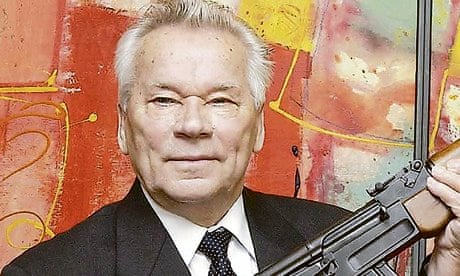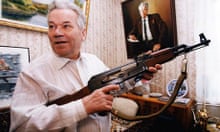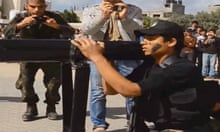Mikhail Timofeyevich Kalashnikov, who has died aged 94, was the Russian designer of the world-famous firearm to which he gave his name. The Kalashnikov rifle, and derivatives of it, have seen service with both regular and irregular forces all over the world. In the hands of the latter, it has become so ubiquitous as to achieve symbolic status. The rifle was ahead of its time when it first appeared in 1947, and continued modifications and redesigns have maintained its potency to the present day.
The weapon is most notable for its reliability in even the most extreme conditions, and its supreme ease of maintenance in the field. These attributes made it equally suitable for the vast conscript army of the USSR and for guerrilla forces of all types and political persuasions. Until relatively recent times little was known of the man who designed this remarkable weapon, but that changed with the era of glasnost.
Kalashnikov was twice made a Hero of Socialist Labour and in many ways he was the very apotheosis of this breed. Self-taught, he produced designs that may be considered the very best of their type. With little formal training he rose to a position of unrivalled pre-eminence in his field – a notable feat given that Soviet weapons development was based on fierce competition among rival designers.
One of a large peasant family, Kalashnikov was born in Kuriya, in the Altai Krai district of southern Siberia. In later life he maintained that, even during his earliest childhood, he felt that he was destined to become a designer. While still a youth, he was forced to flee to avoid questioning by the police over the illegal possession of a pistol. He took work as a railway clerk at Alma-Ata, Kazakhstan.
Kalashnikov's first venture as a designer happened after he had commenced his military service in 1938. He invented a simple device for measuring the performance of tank engines, which proved so successful that it was put into production. His embryonic career was interrupted by the German invasion of the Soviet Union in 1941, when he was recalled to his unit to serve as a tank commander. During the battle of Bryansk, in the autumn of that year, Kalashnikov was wounded in the shoulder and chest. While in hospital he conceived the idea of designing a submachine-gun as a means of alleviating the shortage of small arms that he had witnessed at the front.
Showing remarkable strength of purpose, with his arm still in a sling, he set about producing a prototype, using the facilities in railway workshops: first in his home village, later in Alma-Ata. The finished article initially led to him being arrested by the nervous local authorities, but eventually it was sent for official appraisal. Though the model was considered too complicated for adoption, the exercise ensured Kalashnikov's recognition as a natural talent worthy of proper technical education. Nor was his next design, for a light machine-gun, taken up, but evidently formed part of a valuable learning process.
In 1943 Soviet designers developed a shortened version of the standard 7.62mm rifle cartridge – the bullet and its casing. This was in response to the introduction by the Germans of a similar "intermediate" round. The advantage of such cartridges was that, in contrast to the pistol cartridges fired by submachine-guns, they were effective at all normal combat ranges. Conversely, unlike the powerful standard rifle cartridges of the era, they permitted controllable automatic and semi-automatic fire by relatively light weapons. The theory behind such cartridges had been current in both Germany and Russia for many years, but it took the second world war to give impetus to their actual introduction, thereby commencing a period of fundamental change in rifle design.
Kalashnikov immediately set about designing a semi-automatic carbine for the new cartridge, only to see a version by the established designer Sergei Simonov adopted instead. However, at that point the army decided to commission the development of an assault rifle (or avtomat) capable of both semi- and fully-automatic fire.
In 1946, Kalashnikov, aided by a small team, began work on such a weapon. He employed a modification of the system used in his unsuccessful carbine, wherein gas produced by the firing of the cartridge actuated a piston, which unlocked the bolt by rotating it. The concept was by no means new, but Kalashnikov's engineering genius raised it to a peak of mechanical efficiency.
When it appeared in its finished form, this rifle convincingly outperformed the weapons of rival designers. Kalashnikov later recalled that even before testing had been completed, the respected designer Vasily Degtyarev said: "Take my model to the museum! The Sergeant [Kalashnikov] has won."
The rifle was subsequently adopted for service as the Avtomat Kalashnikova 1947, or AK47. Undoubtedly the finest military rifle of its day, the AK has undergone various modifications since its adoption, the most notable being a redesign in the 1970s to accept a new 5.45mm cartridge, as the AK74.
Variants were manufactured in virtually all the countries of the Warsaw pact, along with China, North Korea, Egypt and Yugoslavia. Finland, Israel, South Africa and India all employ indigenous designs based on the Kalashnikov system. It is impossible to say how many have been produced, but a reliable estimate puts the figure at more than 90m.
Kalashnikov and his design team, based in Izhevsk, in Udmurtia, continued their work into the 1990s, producing squad automatic versions of the Avtomat, and adapting the Kalashnikov system for use in the highly successful PK series of machine-guns. The system was also applied to sporting rifles and shotguns. Their most recent success was the Saiga semi-automatic shotgun, popular among the private security firms that have proliferated in the former Soviet Union.
In recent years Kalashnikov travelled widely outside Russia, generally accompanied by his daughter Elena. As well as being lionised by western firearms specialists, he generated good publicity for the Izhevsk factory, which was now eager to earn foreign currency.
He was the subject of numerous newspaper and magazine articles, and a British television documentary. He also continued to be feted in his own country. On his 75th birthday he was promoted to the rank of general and became the first person appointed to the newly re-established Order of St Andrew. At no time did any of this attention appear to affect his level-headed outlook on life, and he continued, when not travelling, to live in the quiet backwater of Izhevsk, amusing himself by putting his hunting rifles to practical use.
The first western historian to make contact with Kalashnikov was Ed Ezell, of the Smithsonian Institution. In conversation with him in 1989, the great designer confided what he considered to be the secret of his success. He said that designers should have the flexibility to discard their own concepts when necessary; too many of them became attached to their ideas "like a spinster to her cats". Constant reassessment of the validity of one's own ideas allowed the development of reliable weapons. Kalashnikov summed this up in the maxim: "There is no limit to improvement." He maintained that his motivation had been the defence of his country and regretted the subsequent misuse of his weapons round the world.
His wife, Ekaterina, died in 1977, and a daughter, Natalia, in 1983. He is survived by Elena, his daughter Nelli and a son, Viktor.





